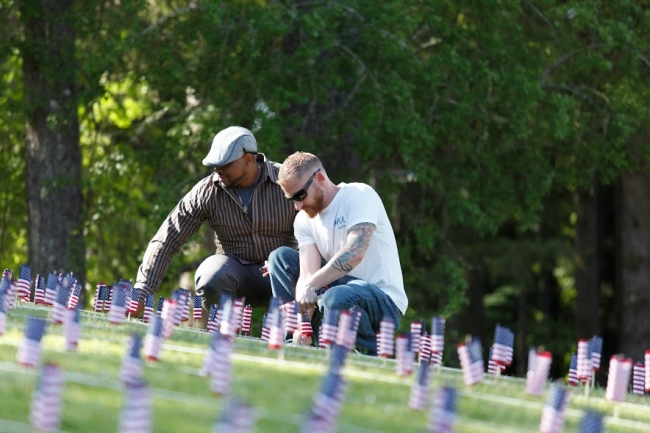You have /5 articles left.
Sign up for a free account or log in.

Evergreen employees and students plant flags to honor U.S. veterans.
Ben Sansiribhan
A self-proclaimed “progressive, public liberal arts and sciences college located in Olympia, Wash., in the beautiful Pacific Northwest” is not where I expected to find a wonderful story about educating undergraduate veterans, even as liberal and progressive as I am.
Let’s start with the first astonishing fact about veterans at Evergreen State College. At Evergreen, 198 students, 5.2 percent of the total 3,787 undergraduates, are veterans. By comparison for this 2016-17 academic year, Yale has 11 undergraduate veterans, Harvard and Williams three, and Princeton one.
By comparison, again, the total undergraduate veteran enrollment in my 2016 annual Inside Higher Ed survey of 36, again self-proclaimed, “most highly selective colleges,” was 643 students, 0.4 percent of the 160,000 undergraduates at these colleges. Only Columbia, with 375 undergraduate veterans, beats Evergreen.
For another impressive Evergreen veterans fact, today, Friday, staff, students and professors will gather to “reap,” as Evergreen says, the 8,000 four-by-six-inch American flags on eight-inch staffs that were planted Wednesday for Memorial Day. In an annual Evergreen tradition, all day Wednesday, community members, students, faculty and staff members from housekeeping to public affairs planted flags on a knoll on the campus, one each for man and woman in the U.S. Armed Forces who has died in the wars in Iraq and Afghanistan.
On planting day each year, the Evergreen veterans’ director, Thomas R. Kelley, a retired US Navy lieutenant commander, first awaits the day’s weather report. “Refreshments have to be ordered for those doing this, either in the rain or in the sun, which determines hot or cold drinks. We always have coffee,” said Kelley, who explained in telephone and email conversations that he is a “mustang officer” -- an officer who began as an enlisted man.
Evergreen President George Bridges a few months ago stopped by to talk with the editors at Inside Higher Ed, and he discussed Evergreen and veterans. The editors asked me to check this out (alas, only by keyboard and telephone). Yet another fact is Evergreen’s institutional modesty about what by any measure is one of the highest commitments to undergraduate veterans in the nation.
Bridges and other senior administrators let those on the front lines at Evergreen do the talking. In my reporting, Evergreen insisted on treating its commitment to veterans, also in the master’s degree programs, as the obvious thing for any college to do. No one was grandstanding. I found the most eloquent statement I have seen on veterans and college in the six-point type of the syllabus of Evergreen’s seminar for veterans returning to college, Veterans’ Next Mission: Crossing the Bridge Between Military and Academic Life. From the syllabus:
“This four-credit course is designed as a meaningful learning experience for active-duty military, veterans and dependents. The core of this course is based on the belief that the most important thing a veteran brings to the higher education community is not only the authenticity of his or her own experience in the business of national defense, but also the experience gained through interactions with diverse populations within their branches of the military and globally.”
Impressive. What would respectable veteran enrollments do to enlighten the hostile campus protests to unfamiliar ideas?
I shiver still at the memory of the Ivy League president several years ago explaining the absence of undergraduate veterans who said, “Veterans can’t do the work.” Again, from the Evergreen veterans’ seminar syllabus: “Your paper should be no more than 35 double-spaced typewritten pages, including title page and abstract.”
An additional focus of the course is “developing the skills, knowledge and abilities that make students successful in higher education.” And supporting the “progressive” elements of Evergreen’s genetic coding -- and how I’d love to sit in -- the primary reading for the course is Catch-22 by Joseph Heller. (I hope the class lingers for a few moments on the photo in the 50th-anniversary edition of the map of Catch-22 Heller drew to write the book.)
From 10 years now of working with veterans at Bunker Hill Community College in Boston, I know the challenge veterans, especially combat veterans, face returning to school. And I know the challenges colleges face supporting veterans. Men and women with perfect SAT scores and 4.0 high school GPAs are usually not those who volunteer, those whom we, the people, send off to wars.
For all subsequent maturity that serving in the military can bring back to school, nurturing academic self-confidence for veterans is difficult, complicated work. Crazy me, I know -- we sent these men and women to war, therefore we must do the work on their return.
Another fact. Rather than fret, Evergreen faces the challenges of supporting and encouraging college-level academic work. “We make sure veterans know that they always have a place they can turn to, no matter what is happening in their lives,” said Kelley. “Whether that be a marriage falling apart, health problems, housing problems, money problems, academic problems, we make sure that veterans know that we are here to alleviate or share that burden.”
The results? More facts: seven percent, 72, of the Evergreen students who completed a bachelor’s degree in the 2015-16 academic year were veterans, Kelley reported. Using the federal outcome measures, the most recent overall undergraduate veterans cohort graduation rate was 78 percent, versus 76 percent for the college as a whole. Evergreen reports a fall-to-fall retention for undergraduate veterans of 79 percent and 81 percent for the subset receiving VA benefits. The overall fall-to-fall undergraduate retention rate is 78 percent.
“When veterans are in the service, they feel like they are part of something bigger than themselves,” said Kelley. We strive to help them understand that in being educated at Evergreen, they are continuing to be a part of something bigger than themselves and that they still have much to contribute to the success of their communities, their country and themselves.”
The recent news for veterans in undergraduate education stays mixed. Cornell announced a commitment to quadruple undergraduate veteran enrollment, to 100 students. Princeton, at last, dropped its ban on accepting transfer students, opening the doors to more veterans … and to more Division I athletes. And two weeks ago Inside Higher Ed reported on one Stanford undergraduate veteran’s struggle to have Stanford align federal veterans’ benefits with the intent of those programs. While selective, wealthy private colleges continue to scramble for reasons for their low veteran enrollment, remember that Evergreen has made this commitment and achieved these results at as a public institution.
Next fall, Bunker Hill will send one veteran to Dartmouth, one to Brown and one to the Massachusetts Institute of Technology. Other campuses, I am sure, have successes, too; a full nationwide survey is more than I can do. What the evidence from Evergreen confirms, with my experience, is that veterans can achieve whatever we in higher education choose to inspire and support veterans to achieve.
Every veteran to MIT? I’d gladly take responsibility for that. Let’s start at the other end. Whoever is telling veterans that former machine gunners are only qualified for a lifetime of entry-level public safety jobs -- and the voices are loud -- must stop. We, the people, trained these men and women to be warriors, and we sent many to war. Those returning deserve our highest expectations. With the rights and privileges appertaining to my position as an obscure columnist, I declare here that colleges collecting GI Bill dollars and letting veterans settle for less than their actual potential have failed.
To all who can look out on their campuses and see 8,000 American flags? Well done.








